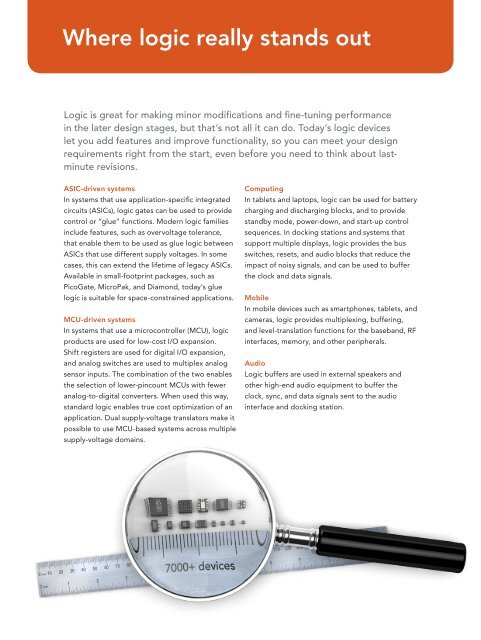Logic selection guide 2016
1Sk34oD
1Sk34oD
Create successful ePaper yourself
Turn your PDF publications into a flip-book with our unique Google optimized e-Paper software.
Where logic really stands out<br />
<strong>Logic</strong> is great for making minor modifications and fine-tuning performance<br />
in the later design stages, but that’s not all it can do. Today’s logic devices<br />
let you add features and improve functionality, so you can meet your design<br />
requirements right from the start, even before you need to think about lastminute<br />
revisions.<br />
ASIC-driven systems<br />
In systems that use application-specific integrated<br />
circuits (ASICs), logic gates can be used to provide<br />
control or “glue” functions. Modern logic families<br />
include features, such as overvoltage tolerance,<br />
that enable them to be used as glue logic between<br />
ASICs that use different supply voltages. In some<br />
cases, this can extend the lifetime of legacy ASICs.<br />
Available in small-footprint packages, such as<br />
PicoGate, MicroPak, and Diamond, today’s glue<br />
logic is suitable for space-constrained applications.<br />
MCU-driven systems<br />
In systems that use a microcontroller (MCU), logic<br />
products are used for low-cost I/O expansion.<br />
Shift registers are used for digital I/O expansion,<br />
and analog switches are used to multiplex analog<br />
sensor inputs. The combination of the two enables<br />
the <strong>selection</strong> of lower-pincount MCUs with fewer<br />
analog-to-digital converters. When used this way,<br />
standard logic enables true cost optimization of an<br />
application. Dual supply-voltage translators make it<br />
possible to use MCU-based systems across multiple<br />
supply-voltage domains.<br />
Computing<br />
In tablets and laptops, logic can be used for battery<br />
charging and discharging blocks, and to provide<br />
standby mode, power-down, and start-up control<br />
sequences. In docking stations and systems that<br />
support multiple displays, logic provides the bus<br />
switches, resets, and audio blocks that reduce the<br />
impact of noisy signals, and can be used to buffer<br />
the clock and data signals.<br />
Mobile<br />
In mobile devices such as smartphones, tablets, and<br />
cameras, logic provides multiplexing, buffering,<br />
and level-translation functions for the baseband, RF<br />
interfaces, memory, and other peripherals.<br />
Audio<br />
<strong>Logic</strong> buffers are used in external speakers and<br />
other high-end audio equipment to buffer the<br />
clock, sync, and data signals sent to the audio<br />
interface and docking station.<br />
6 NXP <strong>Logic</strong> <strong>selection</strong> <strong>guide</strong> <strong>2016</strong>


